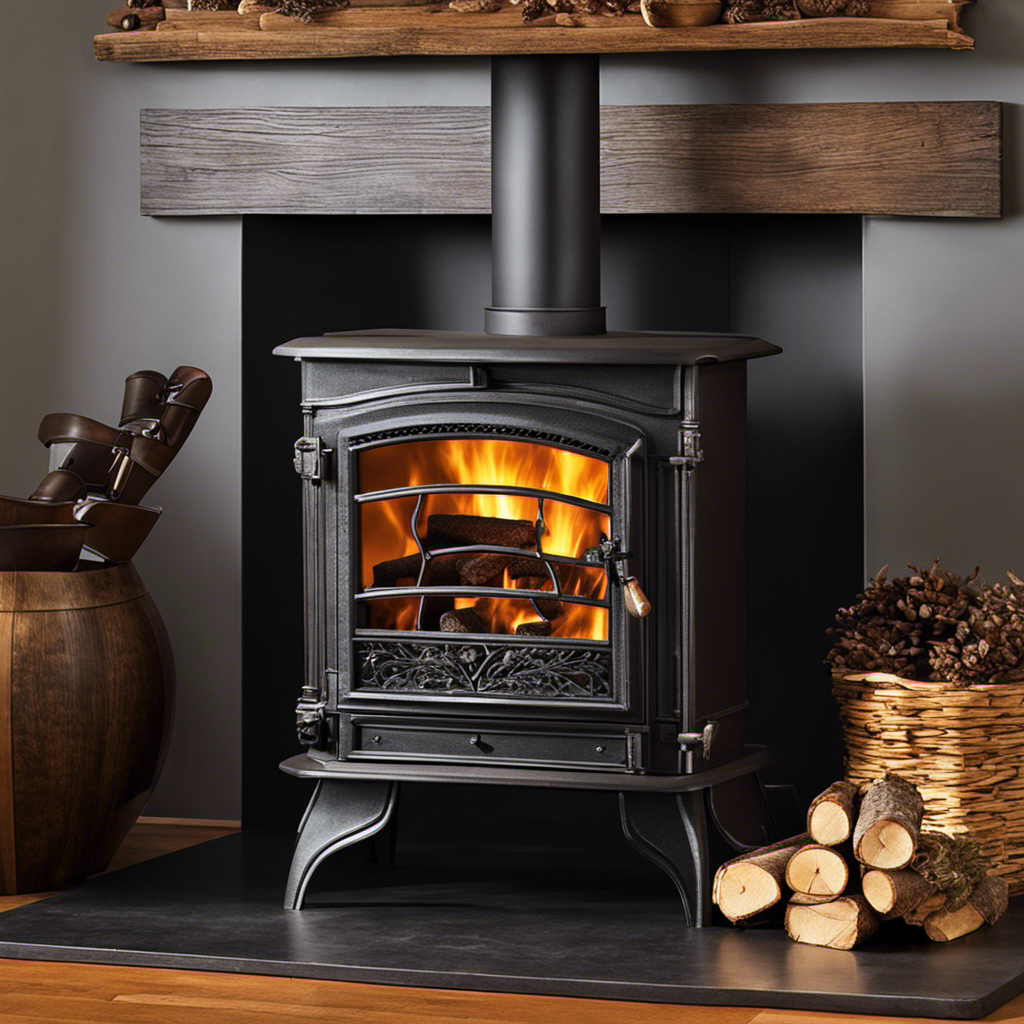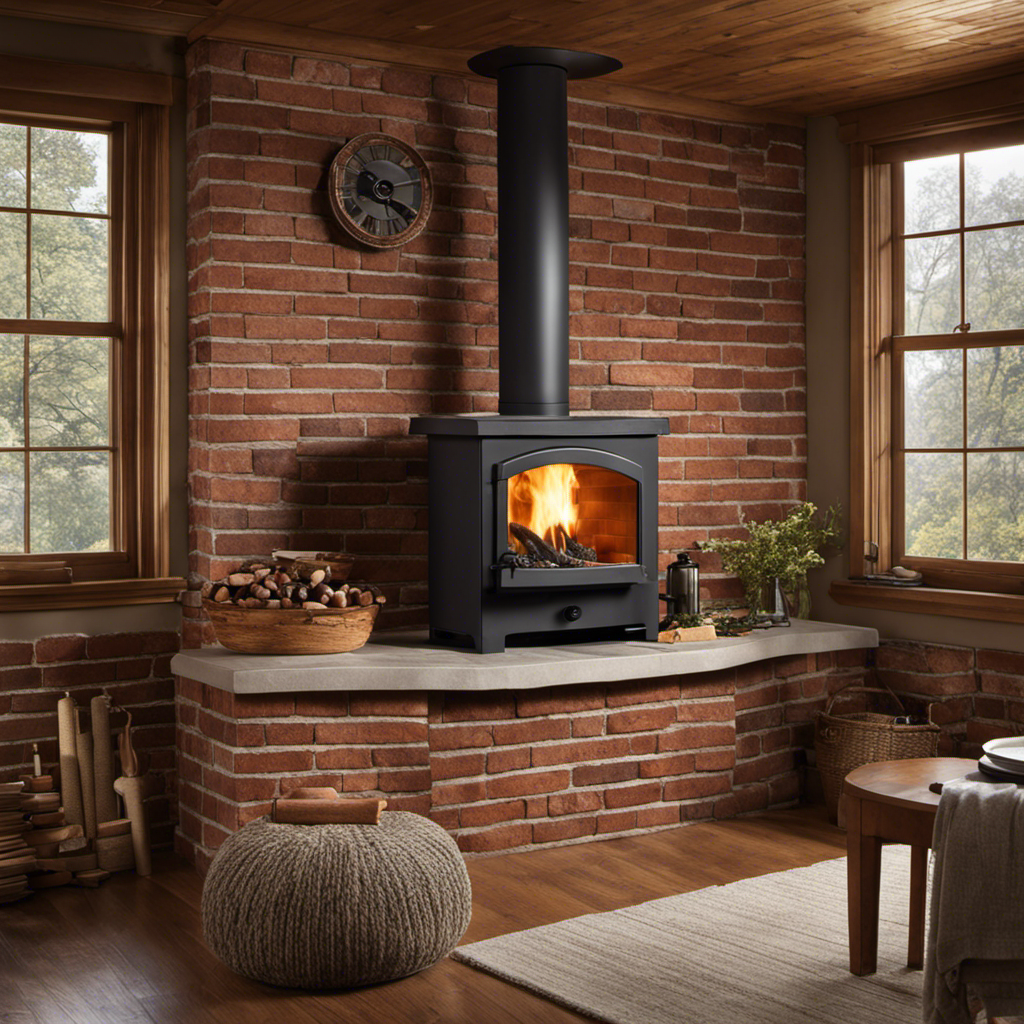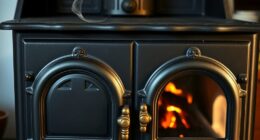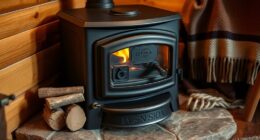I have found a way to prolong the burning time of my wood stove, and I can’t wait to share this secret with you.
Translated in English (United States):
I have found a way to extend the burning time of my wood stove, and I am excited to share this secret with you.
By selecting the right wood, properly seasoning it, and maintaining a clean firebox, you can optimize your stove’s efficiency and enjoy extended heat output.
Plus, I’ll show you how to use heat-retaining accessories and adjust damper settings for even longer burn times.
Get ready to make the most of your wood stove and keep those fires burning!
Key Takeaways
- Select hardwood like oak for a longer burn time.
- Properly season firewood to reduce moisture content.
- Maintain a clean firebox for optimal performance.
- Optimize damper settings to control burn rate and heat output.
Selecting the Right Wood for Your Stove
I love using oak in my wood stove because it provides a longer burn time. Wood moisture content is crucial because wet wood can lead to poor combustion and increased smoke production. It’s recommended to use well-seasoned wood with a moisture content below 20%.
When it comes to selecting the right wood for your stove, it’s important to consider the wood moisture content and choose between hardwood and softwood. Hardwood, like oak, is denser and burns slower, resulting in a longer burn time. It also produces more heat and less smoke compared to softwood. Softwoods, on the other hand, ignite quickly and are great for starting fires, but they burn faster and may require more frequent refueling.
Ultimately, choosing the right wood will ensure efficient and long-lasting heat in your wood stove.
Properly Seasoning Your Firewood
To maximize burn time and efficiency, properly seasoning your firewood is essential. Seasoning firewood involves reducing its moisture content to ensure a clean, hot, and long-lasting fire. One way to achieve this is by using proper splitting techniques. Splitting wood into smaller pieces exposes more surface area, allowing for faster drying.
Additionally, storing the split wood properly is crucial. It should be stacked in a well-ventilated area, off the ground, and protected from rain and snow. This helps to prevent reabsorption of moisture and allows for proper airflow.
By following these steps, you can ensure that your firewood is properly seasoned, resulting in a more efficient burn and longer-lasting fire.
Now, let’s discuss how to maintain a clean and efficient firebox.
Maintaining a Clean and Efficient Firebox
I can keep my firebox clean and efficient by regularly removing ashes and ensuring proper airflow. Maintaining a clean and efficient firebox is crucial for optimal performance and safety. Here are some cleaning techniques and troubleshooting tips to help you achieve that:
-
Regularly remove ashes: Ash buildup can hinder proper airflow and reduce the efficiency of your wood stove. By removing ashes regularly, you can prevent blockages and maintain good combustion.
-
Clean the firebox walls: Over time, creosote and soot can accumulate on the walls of the firebox. Use a wire brush or a specialized cleaner to scrub away any deposits and keep the firebox clean.
-
Check the air vents: Ensure that the air vents aren’t blocked or obstructed. Proper airflow is essential for efficient burning and preventing smoke from entering your home.
Optimizing Damper Settings for Longer Burn Time
In order to optimize damper settings for longer burn time, I adjust the airflow and fuel intake accordingly.
By adjusting the air intake, I can control the amount of oxygen that enters the stove, which directly affects the combustion process. A higher air intake allows for more oxygen, resulting in a hotter and more efficient burn. On the other hand, reducing the air intake slows down the burn rate, allowing the fire to last longer.
Additionally, insulating the stove pipe can help retain heat and improve the overall efficiency of the wood stove. Insulation reduces heat loss and ensures that more heat is directed into the room rather than being wasted through the pipe.
Using Heat-Retaining Accessories for Extended Heat Output
Luckily, using heat-retaining accessories like a stove fan or heat-powered blowers can significantly extend the heat output of my wood stove. These accessories work by maximizing air circulation and distributing the heat more efficiently throughout the room.
In addition to these accessories, there are other ways to maximize the heat output of a wood stove.
-
Insulating materials: By using insulating materials such as firebricks or refractory panels, the heat generated by the wood stove can be better contained within the stove and radiated into the room. This helps to prevent heat loss and ensures that more heat is directed towards heating the space.
-
Proper air circulation: It’s crucial to ensure that there’s adequate air circulation around the wood stove. This can be achieved by positioning the stove in a central location and keeping the surrounding area clear of any obstructions. This allows for better heat distribution and ensures that the maximum amount of heat is released into the room.
-
Regular maintenance: Keeping the wood stove clean and well-maintained is essential for optimal heat output. Regularly cleaning the stove and chimney helps to improve airflow and prevent any blockages that could hinder the efficiency of the stove.
Frequently Asked Questions
Can I Use Softwood in My Wood Stove?
Yes, you can use softwood in your wood stove, but it’s not recommended. Softwood burns faster and produces less heat compared to hardwood. Consider using hardwood or alternative fuel sources for longer burn times and better efficiency.
Are There Any Specific Techniques for Stacking Firewood to Improve Burn Time?
Improving efficiency and maximizing burn time can be achieved by stacking firewood properly. By creating a tight, stable stack with good airflow, you can ensure a longer burn time for your wood stove.
How Often Should I Clean the Firebox to Maintain Efficiency?
I clean the firebox once a month to maintain efficiency. This ensures that the stove operates at its best and burns fuel more effectively. Regular cleaning prevents clogs and allows for a longer burn time.
Can I Use a Wood Stove Without a Damper for Longer Burn Time?
Using a wood stove efficiently is important for longer burn times. While a damper can help control airflow and maximize heat, its absence may limit burn time as it affects the stove’s ability to regulate combustion.
What Are Some Heat-Retaining Accessories That Can Be Used With a Wood Stove?
Heat resistant gloves and stove top fans are essential heat-retaining accessories for wood stoves. These accessories help maximize heat distribution and protect against burns, ensuring a longer burn time and efficient heating.
Conclusion
After following these tips, you’ll be able to enjoy cozy nights by the fire for longer periods of time. Your wood stove will become a reliable source of heat, thanks to the right wood selection, proper seasoning, and regular maintenance.
Adjusting the damper settings and using heat-retaining accessories will further enhance your burn time.
So sit back, relax, and let your wood stove do the work while you relish in the warmth and charm of yesteryear.











